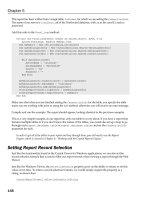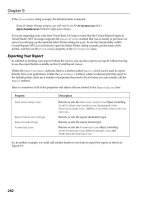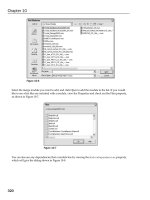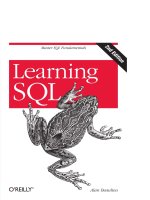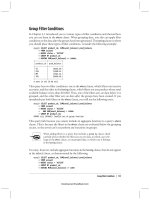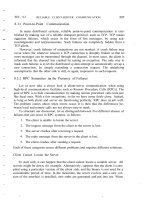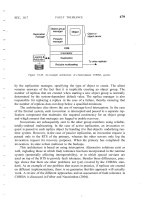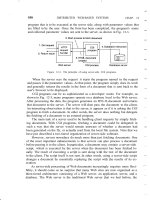head first java second edition phần 6 docx
Bạn đang xem bản rút gọn của tài liệu. Xem và tải ngay bản đầy đủ của tài liệu tại đây (3.13 MB, 68 trang )
exceptions
are
objects
A"
exceptio"
is
a"
object
of
type
Exceptio"_
Which is fortunate, because it would be
much
harder
to
remember
if
exceptions were
of
type Broccoli.
Remember
from your polymorphism chapters that
an object
of
type Exception can be an instance of any
subclass
of
Exception.
Because an Exception is an object, what you catchis an
object. In
the
following code.
the
catch
argument
is declared as type Exception,
and
the
parameter
reference variable is ex,
II
try
to
recover
}
~
This
~od
I
E
tOllvr
I'
~tp£
, I
Iqu
if' Ii
Otl Is tJ.ro'Nrl, "
try
{
th
. I . L \
',\:.t.
4tl.\a't"il'l~
I I
do
risky
J nq ·,t s
J~
\:
.
LI."O
ay~-tl'l
~a
",e'V'"
}
catch(Exception
ex)
{
What you write in a catch block
depends
on
the
exception that was thrown.
For
example, if a server
is down you might use
the
catch block to try
another
server.
If
the
file isn't there, you
might
ask the user
for
help
finding it.
Throwable
getMeasage{)
printStackTraceO
'e.
~.Ltyt.\
OYI
l T'IIl'/
all
T
T\I't"owa'ble
Exception
two
\I.e'(
.>
<,
IOElceeptlon
Intarrupl&dExceptlon
Part J t'he
dass
~lleYaYl.n
t~~O
l.\ass
61'10
il'lheY'It
dho~
322
chapter
11
exception
handling
class
with Q
risky method
.
_': ::
~
I
.
_
Jt
n I
_
""
J.
yourcode
-
If
it's
your
code
that
catches
the
exceptio",
the.,
whose
code
throws
it?
You'll
spend
much
more
of
your
Java
coding
time handling
exceptions
than
you'll
spend
cnatingand
throwing
them
yourself.
For
now,
just
know
that
when
your
code
callsa risky
method-a
method
that
declares an
exception-it's
the
risky
method
that
throws
the
exception
back
to
yfJU,
the
caller.
In reality, it
might
be you who wrote
both
classes. It really
doesn't
matter
who writes
the
code
what
matters is knowing
which
method
throws
the
exception
and
which
method
catches
it.
When
somebody
writes
code
that
could
throw an exception, they
must
declare
the exception.
One
methqd
WIll
entch
VhClt
£lncnher
-
tnetll
o
J
thr9'vv~.
J\n
-
exceptIon
'is
aJVY'ly':i
thl"
O\Vn
back
[o the
elll)e\".
The
111eth<)d
thnt
th\'o
v
v'
~
ha~
t<:>
dechu-e
=
that
'It
nl'ir,
-ht
thrq\\!
the exception.
)
public
void
crossFingers()
(
anObject.takeRisk()j
)
(BadException
ex)
{
System.
out.println
("Aaarqh!
")
; If y
04l
l.i
'.1 r
1I
\.
rU,over
-tror"
ih J,.,
ex
.
printStackTrace
() ;
/
~et.
asicltk
b-
. e
~er
\.Ion,
at
LMsT
~
~i
II
~le
~'~
-the P""ini$tallcTrciteO
tt.hod
a
e-,ttepiior.s
Illherit.
\ tnt
'foI0'I'\0
C'o'1
&od
MVS
1
-\:,t\
~
d~'f-l,eytIO"
•
Risky,
exception-throwing
code:
~,~
"'~
A)
-\:,hat
'I't
t,hyo'OlS
a a
~
ott~Y''''Y
public
void
takeRi.sk
()
BadExcepUon
(
if
(abandonAllHope)
(
new
BadException();
'\l~t:G~
objett
i:;e
w
E~~
/:h ow
it.
•
Your
code
that
calls
the
risky
method:
you
are
here
~
323
checked
and
unchecked
exceptions
E.'Il.ttf"t1Ol\S
thai
aye
NOT
s~t1asu:s
of
Runti",eEuepiic»l
cll"e
thet.ked
.for
by
~c
t.oto.pilcr.
Th~'rc
~Iled
"thetJccd
t"J'-UpiiOflS
Ii
Exception
The
compiler
checks
for
everything
except
RuntimeExceptions.
The
compiler
guarantees:
If you
throw
an exception in your code you must declare it using
the
throws keyword in your method declaration.
If you
call a method that throws an exception (in other words,
a method
that
declares It throws an exception), you must
acknowledge that you're aware of the exception possibility.
One way to satisfy the compiler is to wrap the
call in a try/catch.
(There's
a second way we'Hlook at a little later in this chapter.)
InterruptedExceptlon
~:
Walt
just
a mlnutel Howcome this Is
the
FIRST
time
we ve
had
to try/cate:h an EJcceptlon7 What
about
the
exceptions I've already
gotten
like NullPolnterEJcception
and
the
exceptJon for DlvldeByZero. Ieven
got
a
NumberFormatExceptlon from
the
Integer.parselntO
method.How come we didn't have to catch those?
A.:
The compiler cares about all subclassesof Exception,
unless they are a special type, RuntimeException. Any
exception class
that
extends RuntlmeExceptlon gets a
free pass.RuntimeExceptions can be thrown anywhere,
with
or
without
throws declarations or try/catch blocks.
The complier doesn't bother checking whether a method
declares
that
It throws a RuntimeExceptlon, or whether the
caller acknowledges that they might get that exception at
runtime.
324
chapter
11
Q.:
I'll bite.
WHY
doesn't
the
complier care a
bout
those
runtime exceptions? Aren't
they
Just as likely to bring
the
whole show
to
a stop?
A:
Most RuntimeExceptlons come from a problem in
your code logic, rather than a condition
that
fails at runtime
in ways that you cannot predict or prevent. You
cannot
guarantee the file is there .You cannotguarantee the server
is up. But you
can make sure your code doesn't index
off
the
end of an array (that's what the .length attribute is for).
YouWANTRuntimeExceptions to happen at development
and testing time.You
don't
want to code in a try/catch, for
example, and have the overhead
that
goes
with
it, to catch
something that shouldn't happen In
the
first place.
A try/catch is for handling exceptional situations,
not
flaws
in
your
code, Use
your
catch
blocks
to try to recover
from
situations you can't guarantee wlll succeed.Or at the very
least,
out
a message to
the
user and a stack trace, so
somebody can figure
out
what happened.
• A
method
can
throw
an
exception
when
something
fails
at
runtime.
•
An
exception
is
always
an
object
of
type
Exception.
(Which,
as
you
remember
from
the
polymorphism
chapters
means
the
object
is
from
a
class
thai
has
Exception
somewhere
upits
inheritance
tree
.)
•
The
compiler
does
NOT
pay
attention
to
exceptions
that
are
of
type
RuntlmeException.
A
RuntimeExceplion
does
not
have
tobe
declared
or
wrapped
in
a
try/catch
(although
you're
free
to
do
either
or
both
of
those
things)
•
All
Exceptions
the
compiler
cares
about
are
called
'checked
exceptions'
which
really
means
compiler-<:hecked
exceptions.
Only
RuntimeExceptions
are
excluded
from
compiler
checking.
All
other
exceptions
must
be
acknowledqed
in
your
code,
according
to
the
rules.
• A
method
throws
an
exception
with
the
keyword
throw,
followed
by
a
new
exception
object:
throw
new
NoCaffeineException();
•
Methods
that
might
throw
a
checked
exception
must
announce
it
with
a
throws
Exception
declaration.
• If
your
code
calls
a
checked-exception-throwing
method,
it
must
reassure
the
complier
that
precautions
have
been
taken
.
• If
you're
prepared
10
handle
the
exception,
wrap
the
call
In
a
tJy/catch,
and
put
your
exception
handling/recovery
code
in
the
catch
block.
• If
you're
not
prepared
to
handle
Ihe
exception,
you
can
still
make
the
compiler
happy
by
officially
'ducking'
the
exception.
We'll
talk
about
ducking
a
little
lalerin
this
chapter
.
~
your
penCil
Things you
want
to
do
exception
handIing
~etaco"Mitive
tiP
\ m
somethIng
new,
\f
you're
trying
to ea tryto
learn
make
that\he
/8s1
thln~O~nce
yOU
putthis
before
goIng
to
sleep
.
'can
tear
yourself
book
down
.
(
a ss
u
~
I
~
~
~
O
~
n
yth
\
n
g
else
more
away
from
It)
don
t b
I<
ofa
Cheerios
'"
challenging
t~an
the
d
atlC
me
to
process
what
boX
.
Your
braIn
nBB
Sad
That
could
take
you
've
read
and
lea~
to
'shova
something
a
feW
hoUrs.
If
you
f ur
Java.
some
of
the
new
in
right
on
to~
0
.yo
Java
might
not
'sllek.
.
doesn't
rule
oul
learning
Of
course,
thIS
rldn
on
your
latesl
a
physical
sk1\1.
Wo
K~ICkBOXlng
routine
Ballroom
probably
won'l
affect
your
Java
leamlng.
b
t
res
ulls
read
Ihls
For
the es '
book
{oratleast
1001<
al
the
pictures)
right
before
go
in9
to
sleep
.
What
might
go
wrong
Which of
these
do
you
think
might
throw
an
exceptfon
that
the
com pller would
care
about?
We're
only
looking
for
the
things
that
you
can't
control In
your
code.We did
the
first
one.
(Because
Itwas the easiest.)
'v'
connect to a remote server
_ access
an arraybeyond its length
_ display a window on
the
screen
retrieve data from a database
_ see ifa text file iswhere you
think It is
create
a new file
read a character from the command-line _
you
are
here
. 325
exceptions
and
flow
control
Flow
eontrol
it1
try/catch
blocks
When
you call a risky
method,
one
of
two things
can
hap-
pen
.
The
risky
method
either
succeeds,
and
the
try block
completes,
or
the risky
method
throws an
exception
back
to
your
calling
method
.
(~
lsystem.
out.
println
("We
made
it!");
1
catch
(Exception
ex)
{
System.out.println("failed
U
) ;
If
the
try
succeeds
(doRiskyThlngO
does
not
throw
an
exception)
try
{
(j
Foo
f
int
b
x.doRiskyThing();
f .
getNum
() ;
}
catch
(
Exception
ex) (
~
System.
out.
println
("failed")
;
~stem.out.println("We
made
it!");
-I
try
(
i~!flH
IFoo
f
'<::I'
iot
b
If
the
try
fails
(because
doRlskyThlngO
dOBS
throw
an
exception)
326
chapte r 11
Fh,ally:
for
the
thlttQs
you
wattt
to
do
no
fffatter
what.
If
you
try
to
cook
something,
you
start
by
turning
on
the
oven.
If
the
thing
you
try is a
complete
failure,
you
haue
to turn
off
the oven.
If
the
thing
you
try succeeds,
you
haue
to
turn
off
the oven.
You
haveto turn
off
the ovenno matter what!
A
finally
block
is
where
you
put
code
that
must
run
regardless
of
an
exception.
try
(
turnOvenOn();
x ,
ba
Ice () ;
catch
(BakingException
ex)
ex.printStackTrace()i
)
finally
(
turnOvenOf£();
)
Without
finally, you have to
put
the
tumOvenOffO
in both
the
try
and
the
catch
because
you
have
to turn
off
the oven
JU>
matter
what. A finally
block
lets you
put
all
your
important
cleanup
code
in one
place
instead
of
duplicating
it like this:
try
{
turnOvenOn
()
;
x.bake
o.
turnOvenOff
() ;
}
catch
(BakingException
ex)
(
ex.printStackTrace();
turnOvenOf
f () ;
exception
andling
If
the
try
block
fails
(an
exceptIDn),
flow
control
immediately
moves to the
catch
block.
When the
catch
block
completes,
the finally
block runs.
When the
finally
block
completes,
the
rest
of
the
method
conUnues on.
If
the
tr-y
block
succeeds
(no
exception),
flow
control
skips
over the
catch
block
and
moves to
the finally
block.
When
lhe
finally
block
compleles,
the
rest
of
the
method
continues on.
If
the
try
or
catch
block
has
a
return
statement,
finally
will
still
runl
Flow
jumps
lo
the
finally, then
back
to the
relum.
you
are
here
~
327
flow control
exercise
~yourpendl
Flow
ContPoI
public
class
TestExceptions
{
public
static
void
main(String
()
args)
{
Look at the
c:ode
to the left. What do you
think
the
output of this program would
bel
What do you think
It would be If the third line of the program were
changed to:
String
test.
"yes",
1
AssumeScaryExceptlon extends Exception.
Output when
test
='
"no"
String
test
=
"no
N;
try
{
Systern.out.println("start
try");
doRisky(test);
System.out.println("end
try");
}
catch
(
ScaryExceptioo
se)
{
Systern.out.println("sca:r:yexception");
}
finally
{
System.
out.
println(
"finally")
;
}
System.out.println("end
of
main");
}
static
void
doRisky(String
test)
throws
ScaryException
{
System.out.println
("start
risky");
if
("yes".equals(test))
{
throw
new
ScaryException();
System.out.println(Uend
riskyN);
return;
}
}
ulew JOpua . ,(lIeuy .
UOlldCl»)«l
've)~
.
~SIJ
lJelS .
Nl
uelS
:.5i1,.{.
=
~al
U"4M
ulew lO
pUiI
- Alleuy - .tit
pua
-
A~S!J
pUCI
-
A~SIJ
lJl?1S
- ,VllJelS :.ou. =
l5Cll
UCl1.!M
328
chapter
11
Output when
test
=
"yes"
exception
handling
Pid
we
lIte.,tio.,
that
a
tltethod
ca.,
throw
tMore
tha.,
o.,e
exception?
A
method
can throw multiple exceptions
if
it
dam
well needs
to
. But
a
method's
declaration
must
declare all
the
checked
exceptions it can
throw (although
if
two or
more
exceptions have a
common
superc1ass,
the
method
can
declare
just
the
superclass.)
CatchlnQ
lHultlple
exceptlo"s
The
compiler
will make sure that you've
handled
all the checked excep-
tions thrown by
the
method
you're
calling. Stack
the
catch.
blocks
under
the
try,
one
after the other. Sometimes the
order
in which you stack
the
~:~::~~
~::~~.
~~~~:\r:t
to
that
a
\Itde
late,
public
void
doLaundry()
throws
PantsException,
II
code
that
could
throw
either
exception
public
class
Foo
{
publ
ic
void
go
()
Laundry
laundry
new
Laundry
() ; it
doLa~dr'f()
~
o\WS
a
try
{
Pa"b~uepiiCW\1
i.e
lands
ill the
1/
Pa"b.~~O'r\
utth
blotk.
laundry.doLaundry();
~
}
catch
(PantsException
pex)
{
II
recovery
code
)
Catch(LingerieExcePti~)
(
"., 0''''')
t\lydOIS
a
I I
recovery
code
~
J
d~
'T.
0'\.
it.
\a"as
i"
the
}
L.
i~'t~~.
~h
blot.\t.·
U~ew'it~~tybOl'l
you
are
here
~
329
polymorphic
exceptions
Exceptiotts
are
polytMorphic
Exceptions
are
objects,
remember
.
There
's
nothing
all
that
special
about
one,
except
that
it is a thing that can bethrown.
So like all
good
objects, Exceptions can be
referred
to
polymorphically. A LingerieException
object,
for example,
could be assigned to a ClothingException
reference.
A
PantsException could be assigned
to an Exception
reference
.
You
get
the
idea.
The
benefit
for
exceptions is
that
a
method
doesn't
have to explicitly declare every possible
exception
it
might
throw; it can declare a superclass
of
the exceptions.
Same
thing
with catch
blocks-you
don't
have to write a catch
for
each
possible
exception
as
long
as the catch
(or
catches)
you have can
handle
any
exception
thrown.
@ You
can
DECLARE
exceptions
using
a
supertype
of
the
exceptions
you
throw.
All
eU~QtIS
ho'le
exception
f.~~
as
a
SlI"
cY
to
lass-
IOExceptlon
CloltilngExeeptlon
try
(
@ You
can
CATCH
exceptions
using a
supertype
of
the
exception
thrown.
try
(
~\,
""'I
1.<1"
/
.•
·4-1-UT
~
laundry.
doLaund
ry
() ; . /
C\atn
l
~
.
~
If
Ie
\Jot\a.u
'.
' 0!
I/~
catch(ClothingException
cex)
{
II
recovery
code
330 chapter 11
laundry.doLaundry();
<
·r
t.
i-:-
\;I
' :.l
catch
(ShirtException
sex)
II
recovery
code
exception hand
Just
because
you
CAN
catch
everything
with
one
big
super
polymorphic
catch,
doesn't
always
mean
you
SHOULD.
You could write
your
exc
eption-handling
code
so
that
you
specify
only
one
catch
block
,
using
the
supertype
Exception
in
the
catch clause, so
that
you
'll
be
able
to
catch
anyexception
that
might
be
thrown.
try
{
l a
und
ry.d
oLaundr
y();
}
catch
(Exception
ex)
{
blotk
w
ill
w"~T?
Tn,s
tatt
n
,
I I r ecov
er
y
cod
e .
~
Rt.t.ol/t.'('(
.{:'(0f'I
-b
so
'(()II.
WOYlt
L'h
~N'I
ay,G
all
t.~t.t.f
oY\S,
ta-u-
\
t
wt.\'It
WV'o\'l~
'
a~~atit.all'f
k\'low
wna
Write
a
different
catch
block
for
each
exception
that
you
need
to
handle
uniquely.
For
example,
if
your
code
deals
with
(or
recovers
from)
a
TeeShirtException
differently
than
it
handles
a
LingerieException,
write a
catch
block
for
each
.
But
if
you
treat
all
other
types
of
ClothingException
in
the
same
way,
then
add
a
ClothingException
catch
to
handle
the
rest.
try
{
l
aun
dry.doLau
nd
ry();
.J.i
"s
3Y10
:t.
S\iAt
1L
t.t
vO
0
o,~h'(eYl
}
catch
(TeeShirtException
tex)
{
~
Tee'
.\:;IOYlS
Ylet.
I,;
ll.,t.'(iet
1Le\,
s
ov.\o.
~e
I I r e c
ov
e r y
fro
m
Tee
Shir
tE
xc
ep
tiol
'YI;.I '-J
t,oOel
so
,!0II0"
~
fu
'(et,o\lt.'( I tt.
'o\ot"s.
~
o,~~t.'t't.Ylt.
t,a
}
catch(LingerieException
lex)
{
All
oihet-
CI
th' E
o
/tI~
Xlt,nJ.
·
Ut"t,
talAaht
h r I./QtlS
J et-t,.
I I
rec
ove r y
fr
om
al
l
ot
h
ers
}
you are here .
331
order
of
multiple catch blocks
Multiple
catch
blocks
iMust
be
ordered
froiM
stttaliesf
to
biggest
Clothing
Exception
catch(TeeShirtException
tex)
catch
(ShirtException
sex)
catch(ClothingException
cex)
332
chapter
11
The
higher
up
the
inheritance
tree, the bigger
the
catch 'basket', As you move down
the
inheritance
tree, toward
more
and
more
specialized Exception
classes,
the
catch 'basket' is smaller. Ir'sjust plain old
polymorphism.
A ShirtException catch is big
enough
to take
a TeeShirtException or a DressShirtException
(and
any future subclass of anything that extends
ShirtException). A C1othingException is even bigger
(i.e.
there
are
more
things
that
can be referenced
using a ClothingException type).
It
can take an
exception of type ClothingException
(duh),
and
any ClothingException subclasses: PantsException,
UnifonnException, Lingerielixception,
and
ShirtException.
The
mother
of
all catch
arguments
is type Exception; it will catch any exception,
including
runtime
(unchecked)
exceptions, so you
pro
bably
won't
use it outside
of
testing.
\
You
cat1"t
put
bigger
baskets
above
stMalier
baskets.
Well, you can
but
it
won't
comp
ile. Catch
blocks are
not
like overloaded m
ethods
where
the
best
match
is picked. With catch
blocks, theJVM simply starts at the first
one
and
works its way down
until
it finds a catch
that's
broad
enough
(in
other
words, high
enough
on
the
inheritance
tree) to
handle
the
exception.
lfyour
first catch block is
catch
(Exception
ex).
the
compiler
knows
there's
no
point
in
adding
any
others-they'll
never be
reached
.
try
(
l aundr
y.
doLaundr y () ;
catch(ClothingException
cex)
{
II
recovery
from
ClothingE
xception
catch
(Linge.rieExc:eption
lex)
{
II
recovery
from L
ingerieException
catch(ShirtException
sex)
{
II
rec
overy
fro
m
ShirtExcep
tion
exception
handling
Size matters when
you have multiple catch
blocks.
The one with
the
biggest
basket has to be on
the
bottom.
Otherwise,
the
ones with
smaller baskets are useless.
Siblings
can
be
in any order,
because
they
can't
catch
one
another's
e~tions.
You
could put
ShirtException
above
Unger
ieException
and nobodywouldmind
Because
even though
ShlrtException
isa bigger
(broader)
type
because It caneateh other classes
(its own subdasses),Sh
irtException
can'tcatcha
UngerieExceptlon sothere'sno problem.
you
are
here
~
333
polymorphic puzzle
~n
your
pencil
try
{
x ,
doRisky
() ;
catch(AlphaEx
a) {
II
recovery
from AlphaEx
catch
(BetaEx
b)
{
II
recovery
from
BetaEx
ca
toh
(GammaEx
c)
II
recovery
from
GammaEx
cateh(DeltaEx
d) {
II
recovery
from
DeltaEx
BazEl
T
FooElr
.>
<,
8esEJ
BIIlEJ
<.
334
cha pt
er
11
Assume the try/catch block here Islegally coded.Yourtask isto draw
two different class diagrams
that
can accurately reflect
the
Exception
classes. In other words,
what
class Inheritance structures would make
the
try/catch blocks in
the
sample code legal?
Yourtask isto create two different legal try / catch structures (similarto
the
one
above left),to accurately represent
the
class diagram shown on
the
left
Assume ALLof these exceptions might be thrown by
the
method
with
the
try block.
exception
handling
Whe.,
you
dO.,/t
wa.,t
to
ha.,dle
a.,
exceptiott
iust
dUCK
it
If
you
don't
want
to
handle
an
exception,
you
can
duck
it
by
declaring
it.
When
you call a risky
method,
the
compiler
needs
you to
acknowledge
it. Most
of
the
time,
that
means
wrapping
the
risky call in a try/
catch. But you have
another
alternative, simply
d1Ukit
and
let
the
method
that
called you
catch
the
exception.
It's
easy-all
you have to do is
declare
that
youthrow
the
exceptions. Even
though.
technically, you
aren't
the
one
doing
the
throwing. it
doesn't
matter. You're still
the
one
letting
the
exception
whiz
right
on
by.
But
if
you
duck
an
exception,
then
you
don't
have a
try/catch,
so
what
happens
when
the
risky
method
(dol.aundry/)
)
does
throw
the
exception?
When
a
method
throws an
exception,
that
method
is
popped
off
the
stack immediately,
and
the
exception
is
thrown
to
the
next
method
down
the
stack-the
caller.
But
if
the
calleris a ducker,
then
mere's
no catch for it so
the
caller
pops
off
me
stack immediately,
and
the
exception
is thrown to
the
next
method
and
so
on
where
does
it
end?
You'll see a
liul
elate
r.
public
void
foo()
throws
II
call
risky
method
laundry.doLaundry()
;
}
!
!
you
are
here.
335
handle
or
declare
Uuckhtg
(by
declaring)
only
delays
the
inevitable
Sooner
or
later,
somebody
has
to
deal
with
it.
But
what
If
MainO
ducks
the
exception?
public
class
Washer (
Laundry
laundry
= new
Laundry(J;
public
void
fool)
throws
ClothingException
laundry
.doLaundry();
public
static
void
main
(String[
]
argsl
throws
ClothingException
(
Washer a = new
Washer(
);
a
.fooO;
o
doLaundryO
throws
a
ClothingException
fooD ducks
the
exception
mainO ducks
the
exception
The
JVM
shuts down
mainO calls focO
fooO calls doLaundryO
doLaundryO is
running and
throws
a
ClothingException
doLaundryO pops
off
the
stack
immediately and
the
exception is thrown
back to fooO.
But fooD doesn
't
have a
try/catch
. so
fooD pops
off
the
stack
immediately and
the
exception is thrown
back to who? What'?
There
's nobody
left
but
the
JVM, and it's
thinking. "Don't
expect
ME to
get
you
out
of
this."
We're us)ng the tee-sh irt to represent a Clothing
Exception. We know, we know you would
have preferr ed the blue Jeans.
336
chapter
11
}
exception handling
Handle
or
Declare.
It's
the
law.
So
now
we've
seen
both
ways
to
satisfy
the
compiler
when
you
call
a
risky
(exception-throwing)
method
.
•
HANDLE
Wrap
the
risky call ina
try/catch
This
had
betta- b b'
try
{
»<"">
ha",dle
all
extepti e a
thl~
e",o~h
tatth
laundry.
doL
aund
ry
() ;
~
iaht
~
I'\.
OI'IS,
at
doLa~",dt"yC)
J
t"ow.
vr
ese th t
'1
}
catch
(ClothingException
cex)
{ still to
pl
'
~1L
1- I e
OIftPI
et"
will
a,,,,
'toa't
yo~
toe
t
Lh
/ /
rec
o
very
code of th
••
v.
,.,L. "'0
tau
i",~
all
"",er"IOI'IS
.
• DECLARE
(duck
it)
Declare
that
YOUR
method throws
the
same exceptions
oil
tnvoo-"s
a
as
the
risky method you
're
calling. .1 1
",W'dvo'.l)
e-\:.n
\ . Q tnt
int
lo'o\ A01~
b~t
b'(
dtt.
avo''';,
void
foo
()
throws
ClothingException
{
C\otni,,~~1Ltyti;"~O
ttnod
~c\:.s
to
laundry.
doLaundry
() ;
~
~tytio",
tnt
J.'OY\'
No
tVO'fIt.atJ,n
.
d~\c.
tnt
t1L
t
r
'"
But
now
this
means
that
whoever calls
the
fooO method
has to follow
the
Handle or Declare
law.
If
fooD ducks
the
exception (by declaring it), and
mainO
calls fooO, then
mainO
has to deal with
the
exception.
pUblic
class
Washer
{
Laundry
laundry
= new
Laundry();
public
void
fo
o()
thr
ows C
lot
hi ngExcept i on
laundry.d
oL
aundry();
public
stati
c
void
main
(String[]
ar
gs
)
W
asher
a = new
Washer();
a c f oo
Ij
r
~
Beta~e
the
+000
tihod
d~ks
the
CI~hi",~ExteptiOl'l
tht"OWl'l
by
doLa~",dt"vI')
a,,,,()
has
to a
,.
() T: I
Wt" P a
·1"OO
i",
a tt"y/tatth
at"
ai",O
has
to
detlat"e
that
it,
too,
,
ih
ows
Cloihi",~ExtertjOl'l!
you are her
e.
337
fixing
the
Sequencer
code
G-effittg
back
to
our
tMusic
code
Now
that
you've
completely
forgotten,
we
started
this
chapter
with a first
look
at
some
JavaSound
code. We
created
a Se-
quencer
object
but
it
wouldn't
compile
because
the
method
Midi.getSequencerO
declares a
checked
exception
(MidiUnavail-
ableException).
But
we
can
fix
that
now
by
wrapping
the
call in a
try/catch.
public
void
play()
try
{
Sequencer
sequencer
=
MidiSystem.getSequencer();
System.out.println(~Successfully
got
a
sequencer");
}
II
close
play
Exception
Rules
• You
cannot
have
a
catch
or
finally
without
a
try
void
go
() {
t-/Oi
~~~~~\
?
Faa
f =
new
Faa
() ;
wnt.V"i
s
-tnt
-t
y
'1
'
f.
foof
() ;
catch(FooException
ex)
{ }
•
You
cannot
put
code
between
the
try
and
the
catch
NOT
Lf &:A
try
{ "': L!
VOlA
".
'1
lode h t
11
1;
P"t
x ,
doStUff/()
; 1. e
weell
the try
~~
) "Ule ldtth.
Ii""
int
y =
43;
}
catch(Exception
ex)
{ }
try
{
x.doStuff();
finally
{
II
cleanup
• A
try
with
only
a
finally
(no
catch)
must
still
declare
the
exception.
void
got)
throws
FooException
{
try
{
x.doStuff()
;
}
finally
{ }
338
chapter
11
Code
Kitchen
exceptJon
handl
ing
.:
(
You
don't
have
to
do
it
yourselt,
but
it's a
lot
more
fun
if
you
do.
Tlte
rest
01
tlUs
chapter
is
optionaL
you
can
use
ReaJy-
bake
code
tor
all
the music
apps.
But
it
you
want to learn
more
about
JllvaSouncl,
turn
the
rage.
you
are
here
~
339
JavaSound
MIDI
classes
Making
actual
sound
Remember
near
the
beginning
of
the
chapter, we
looked
at
how MIDI
data
holds
the
instructions for what
should
be played
(and
how
it
should
be played)
and
we
also said
that
MIDI
data
doesn't
actually
create
anysound that you
hear.
For
sound
to
come
out
of
the
speakers,
the
MIDI
data
has
to be
sent
through
some
kind
of
MIDI device
that
takes
the
MIDI instructions
and
renders
them
in
sound,
either
by
triggering
a
hardware
instrument
or
a 'virtual'
instrument
(software synthe-
sizer). In this book.
we're
using only software devices, so
here's
how
it works in
JavaSound:
You
need
FOUR
things:
The
actual music
Information:
notes
to
play,
how
long,
etc.
e
9
e
9
A MIDI event is a message
that
the Sequencer can
understand. A MIDI event
might
say(if It spoke
English),"At this
moment
In time, play middle C,play
It this fast and this hard,
and
hold
It for this
long."
A MIDI event
might
also saysomething like,
"Change the current
instrument to
Flute."
holds
The
part
of
the
Sequence
that
holds the actual
Information
Track
For this book, we only
need one Track,soJust
Imagine a a music CD
with
only
one song. A
single Track.ThisTrack
Is where all the song
data {MIDI Information)
I1ves.
•
The Sequence is the
song, the musical piece
that
the Sequencer
will
play. For this book,
think
of the Sequence as a
music CD,
but
the
whole
CDplays
just
one
song.
• The music
to
be
playtd
o song.
plays has a
Sequencer
~
Sequence
~
eD
The
thing
that
plays
the
music
The Sequencer Is the
thing
that actually causes a song
to be played. Think of It like
a music CD player.
340
chapter 11
And you
need
FIVE
steps~
Get a
Sequencer
and open
it
Sequencer
player
=
MidiSyscem.gecSequencer();
player
.openl);
Make a new
Sequence
Sequence
seq
= new
Sequenceltiming,4);
• Get a new
Track
from
the
Sequence
Track
t =
seq.createTrack();
• Fill
the
Track
with
MidiEvents
and
give
the
Sequence
to
the
Sequencer
exception
handling
player.
start
();
t.add(myMidiEventl);
player.setSequencelseq);
you
are
here
~
341
a sound application
Your
very
first
sound
player
app
Type it in
and
run
it. You'll
hear
the
sound
of
someone
playing a
single
note
on
a piano! (OK, maybe
not
someone,
but
something.)
import
javax.sound.midi.*;
public
class
MiniMiniMusicApp
{
pUblic
static
void
ma
in(Str
ing[]
args)
{
MiniMiniMusi
cApp
mini
= new
MiniMiniMusicApp();
mini.play();
II
clo
s e m
ain
(
try
{
publi
c
void
play()
a
.
·
.~
"
•
Sequen
cer
player
pl
aye
r .open () ;
Sequence
seq
= new
MidiSystem.getSequencer();
Tr
a
ck
track
=
seq.cr
eateTrack();
ShortMessage
b = new
ShortMessag
e()i
b.
setMes
sage
(128,
1,
44,
100);
MidiEv
ent
n
oteOff
= new
MidiEvent(b,
track.add(noteOff);
Sh
ortMes
sage
a = new
ShortMessage();
a.setMessage(144,
1,
44,
100);
Mid
iE
vent
n
oteOn
= new
MidiEvent(a,
1);
tra
ck.add(noteOn);
PlAt
SOMe
MidiEvetl'ts
into the T
-sek.
This
fart
is
Mostly
Ready-bake
tode. The
only
thin~
YOlA'1l
have
to tare
abolAt
al'"e
the
al'"~llMents
to the
setMessa~e()
""ethod,
and the
al'"~llMents
to
the
MidiEvent
t.onshlAtk.
We'/Ilook
at
those
al'"~llMents
on
the
ne1l.t
ra~e
.
player.
set
Sequence
(seq);
~
qive
the
Se,\llent.e
to
the
Se,\llent.er
(like
pla
yer.
start
();
4:
flAH
in~
the
CD
in the
cD
fla-yel'")
Sfdl'"i()
the
catch
(Exc
eption
ex)
{
SeC(llehter
Oike
PlASh
'
e
x.
pr i nt St
ac
kTr
ace
();
'n~
PLAy)
} I I c l o s e
pla
y
I I
clo
s e c
lass
342 chapter 11
exception handling
Makit1g
a
MidiEvettt
(SOttg
data)
A MidiEvent is an
instruction
for
part
of
a song. A series
of
MidiEvents is
kind
of
like
sheet
music,
or
a
player
piano
roU. Most
of
the
MidiEvents we
care
about
describe a thing to do
and
the
momentin time to do it.
The
moment
in time
part
matters, since
timing
is everything in music.
This
note
follows
this
note
and
so on.
And
because
MidiEvents
are
so detailed, you have to say
at
what
moment
to startplaying
the
note
(a
NOTE
ON event)
and
at
what
moment
to
step
playing
the
notes
(NOTE
OFF
event).
So you
can
imagine
that
firing
the
"stop playing
note
G"
(NOTE
OFF message)
before
the
"start
playing
Note
en
(NOTE
ON)
message
wouldn't
work.
The
MIDI
instruction
actually goes
into
a Message
object
; the MidiEvent is
a
combination
of
the
Message plus
the
moment
in time when
that
message
should
'fire'. In
other
words,
the
Message
might
say, "Start playing Middle
C" while
the
MidiEvent would say. "Trigger this message at
beat
4".
So we always
need
a Message
and
a MidiEvent.
The
Message says what to do,
and
the
MidiEvent
says
when to do it.
• Make a Message
ShortMessage
a = new
Shor~Message();
1
MidiEVent
says
whBt
to
doand
~todo~
Everg~on
must
include
the
~s.fortbat
in8tJtuction
In
other words,
at
which
beat that
-
thing
ahould
happen.
• Make Q new MidlEvent using
the
Message
• Put
the
Instruction in
the
Message
"start
y\a'li,,~
~
~.y
a.
se~Message
(144,
1,
44,
100);
~(-
Th~
~~e
s.a~
othtT
""",'oeYS
Ol\
~e
(~e'\\
\oo\t
at &e
"Vot.
ya~e)
• Add
the
MidiEvent
to
the
Track
you
are
here
~
343
contents
of
a Midi event
MIPltttessage:
the
heart
of
a
MidiEvet1f
A MIDI message holds
the
part
of
the
event
that
says
toha: to do.
The
actual instruction
you
want
the
sequencer
to execute.
The
first
argument
of
an instruction is
always
the
type
of
the
message.The values
you
pass to
the
other
three
arguments
depend
on
the
type
of
message. For example, a message
of
type 144
means
UNOTE
O~'·.
But
in
order
to carry
out
a
NOTE
ON. the
sequencer
needs
to know a few things.
fuiagine
the
sequencer
saying.
~OK,
I'll
playa
note,
but
whu:h
chantul? In
other
words. dc/you want me to
playa
Drum
note
or
a
Piano
note?
And
which
note?
Middle-C? D Sharp?
And
while
we're
at it. at
which
I
vekJcity
should
I play
the
note? \
,
To make a MIDI message, make a ShortMessage instance
and
invoke setMessageOI passing
in the four
arguments
for
the
message.
But
remember,
the
message
says
only iahiu
u»
do. so
you still
need
to
stuff
the
message
into
an event
that
adds
when
that
message
should
'fire'.
Anatomy
of
a
message
The
first
argument to setMessageO always
represents
the
message
'type', while
the
other
three
arguments represent
different
things
depending on
the
message type.
~t.
~"\
-:>r>f"
il'c.
Jd,
V
~
~~
t;
~
'(P -
~f:j
a.setMessage(144,
1,
44,
100);
neldsf.3~
tyP
' .
~
Yd'ry
dej>eJldj
e.
Thl$
1$ i
NOTE
~
0I'l
~
~
~~
~~~
~
f.o
~
.il"t
tot"
tJ.
. .1,
~t,
so the
k"o'ol
i"
ot"d
.1
'~s
U1t
St,~
~
"[D
rl.y •
"ote.
"eedt
~
Message type
344
chapter
11
The
Message
says
what to
do,
the
MidiEvent
says
when
to
do
it,
• ChoMel
Think
of
a channel like a musician in
a band. Channell is musician 1
(the
keyboard player),
channel
9 is
the
drummer, etc.
• Note to play
A number
from
0 to 127, going
from
low to high notes.
• Velocity
How fast and hard
you press
the
key? 0 is so
soft
you
probably won't hear anything,
but
100 is a
good default.
Chat1ge
a
tMessage
Now
that
you know what's in a
Midi
message, you can start
experimenting.
You
can
change
the
note
that's
played, how
long
the
note
is held,
add
more
notes,
and
even
change
the
instrument.
exception
handling
•
Change
the
note
Try
a number between 0 and 127 in
the
note
on and note
off
messages.
a.
setMessage
(144,
1,
20,
100);
-
•
Change
the
duration
of the note
Change
the
note
off
event (not
the
message)
so
that
it
happens
at
an earlier
or
later
beat.
b.setMessage(128,
1,
44,
100);
MidiEvenc
noteotf
= new
MidiEvent(b,
3);
-
Change
the
instrument
Add a new message,
BEFORE
the
note-playing message,
that
sets
the
instrument in
channell
to something
other
than
the
default
piano.
The change-instrument message
is '192', and
the
third
argument represents
the
actual
instrument
(try
a number between 0 and 127)
you
are
here
345
change the
instrument
and
note
and
note
args");
,/
/ /
thiS
£'
the
first
one
I
args
;) (
Mini~usiccmdL
ine();
public
static
void
main(Scringl)
MiniMusicCmdLine
mini
= new
if
(a
rqs
.length
< 2) (
System.ouc.println("Don'C
forget
che
instrument
else
(
int
instrument
=
Integer.parse
lnt(argsIO])i
int
note
=
Integer.parselnC(args[l)l;
mini.play(instrumenc,
note);
public
class
MiniMusiccmdLine
This version still plays
just
a single
note
,
but
you
get
to use
command-line
argu-
merits to
change
the
instrument
and
note
.
Experiment
by passing in two
int
values
from 0 to 127.
The
first
int
sets the instrument,
the
second
int
sets
the
note
to play.
import
javax.sound.midi.*;
) 1/ c
los
e
mai.n
public
void
play(int
instrument,
int
note)
{
try
Sequencer
player
=
MidiSystem.getSequencer();
player.open();
Sequence
seq
= new
Sequence(Sequence.PPQ,
4);
Track
track
=
seq.createTrack(),
MidiEvent
event
=
null;
ShortMessage
first
= new
ShortMessage();
first.
setMessage
(192,
1,
instrument,
0);
MidiEvent
changelnstrument.
= new
MidiEvent
(first,
track.add(changelnstrument);
1)
;
ShortHessage
a = new
ShortMessage();
a.setMessage(144,
1,
note,
100);
MidiEvent
noteOn
= new
MidiEvent(a,
1);
track.add(noteOn);
Rvr.
rt
wi~
two
i"i
~
-h-Ot'<'.
D
iD
J'}
7.
Try that:
few
~
ShortMessage
b
~
new
Shor~essage();
b.setMessage(12B,
1,
note,
100);
MidiEvent
noteOff
= new
MidiEvenc(b,
16);
track.add(noteOffl,
player.setSequence(seq);
player.
start
();
%java
MiniMusicCmdLine 102 30
%j ava MiniMusicCmdLine 80 20
~
j
a
v
a
MiniMusicCmdLine
40 70
I
catch
(ExCeption
ex)
(ex.printStackT
race();)
I / /
cl
os
e p
la
y
/ I
cl ose
cla
s s
346
chapter
11


